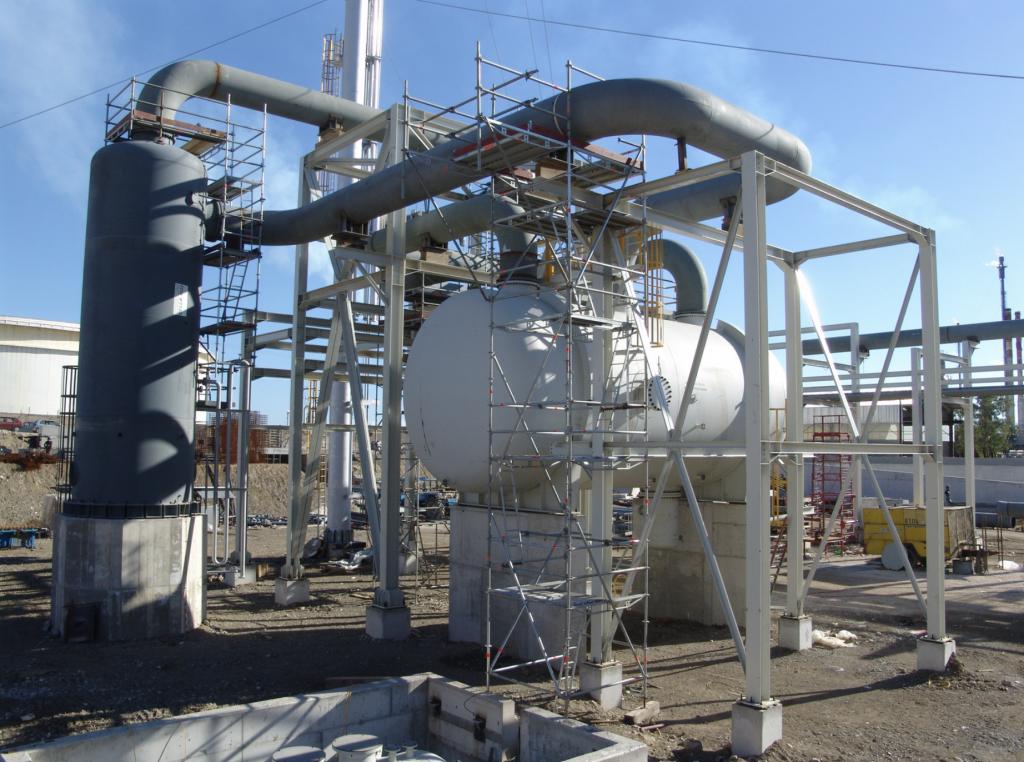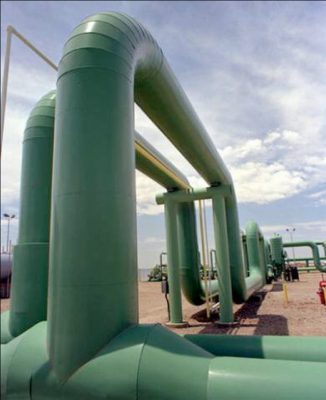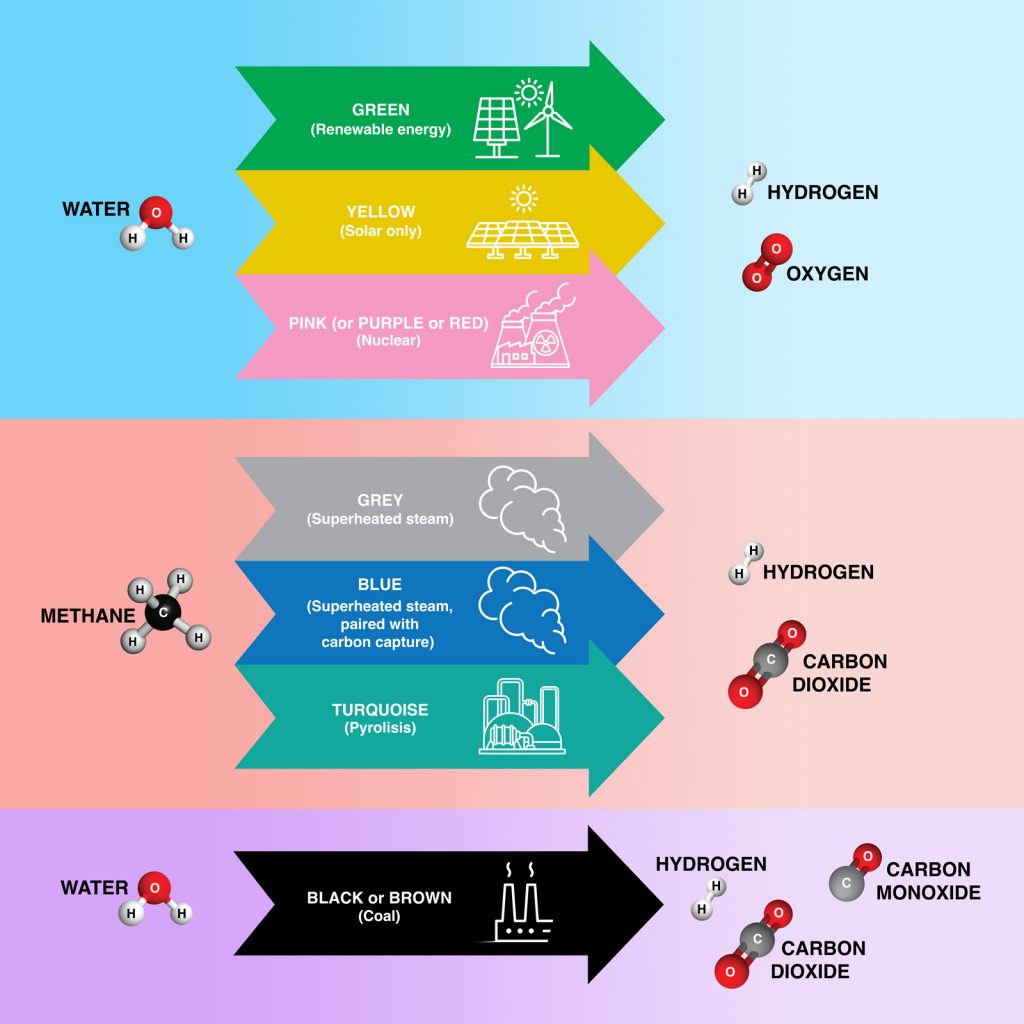Front Porch Blog
Editor’s note: The U.S. Department of Energy announced the selection of the Appalachian Regional Clean Hydrogen Hub as one of the winners of the Regional Clean Hydrogen Hubs grant programs on Oct. 13, 2023. Read our press release on the announcement and the impact hydrogen energy production could have on our region.

Stock image of a hydrogen facility.
This potential energy resource received significant federal subsidies in the climate package to make it more cost-competitive — meaning hydrogen could be competing against renewables to power the grid of the future. For example, the federal government pledged $8 billion in the Infrastructure and Investment Jobs Act for the buildout of “hydrogen hubs” while the Inflation Reduction Act created a production tax credit worth $13 billion for qualifying types of hydrogen.
Defining ‘hydrogen hub’
The term “hydrogen hub” refers to planned networks of hydrogen producers and consumers connected by local infrastructure. Hubs are intended to accelerate the use of hydrogen for energy and industry, and will be sites of production and processing, export, storage, and research and development.
Hydrogen gas is of interest to the federal government for its range of potential uses, including as a low (potentially zero) carbon electricity supply but also because it could reduce emissions of otherwise “hard-to-decarbonize” elements of the transportation, agricultural and industrial sectors. Hydrogen production in Central Appalachia is a real possibility, so we’re unpacking this technology and exploring its potential impact on the health of communities and ecosystems in our region.
Background
Hydrogen gas consists of two bonded hydrogen atoms. As the resulting molecule doesn’t occur naturally in the environment, hydrogen gas must be produced. This can be accomplished in a variety of ways, each denoted by a color-themed name based on the fuel source that powers production of the gas.
While there’s a full “rainbow” naming methods of hydrogen production, we’re most concerned with “gray,” “blue” and “green” hydrogen, as these are the focus of new federal funding opportunities.But hydrogen is a colorless gas — so what distinguishes gray from blue from green hydrogen?
- Gray hydrogen is sourced by processing fracked (methane) gas in steam form, which essentially breaks the methane molecule (CH4) apart to retrieve the hydrogen atoms while leaving the carbon atom behind. Without carbon capture, gray hydrogen results in carbon emissions.
- Blue hydrogen is sourced by processing methane gas (the same as gray hydrogen), but this method is paired with carbon capture to potentially reduce carbon emissions, though researchers estimate that total emissions associated with blue hydrogen are only 9-12% less than from gray.
- Green hydrogen is produced via the process of water electrolysis, which splits water (H2O) — instead of methane — to produce hydrogen molecules. This type of hydrogen gas production has the potential for zero emissions, depending on whether renewables power the energy-intensive electrolysis process and how they are accounted for.
Defining ‘carbon capture’
“Carbon capture” refers to a suite of technologies that capture carbon dioxide emissions from large sources of pollution. Captured carbon dioxide can be used on-site, exported or injected into deep geological formations (like depleted oil and gas reservoirs) to trap carbon for permanent storage.
While gray, blue or green hydrogen are new to many of us, these are actually decades-old technologies that have been prohibitively expensive to produce — until very recently. If hydrogen gas becomes less costly, it could increasingly be used by industry and agriculture to, among other things:
- Replace coke (a coal-based fuel) in the steel smelting process;
- Replace methane gas in the aluminum refining process; and
- Reduce the cost of ammonia-based fertilizers (which require hydrogen).
Additionally, the transportation and utility sectors are interested in its potential power as:
- A fuel source for cars and trucks, rail, shipping or aviation (by itself or in hybrid biofuels); and
- A source of electric storage by itself or as a power source when blended with methane gas (for marginal greenhouse gas emission reductions), which could potentially displace renewables like wind and solar.

Hydrogen pipelines. Photo courtesy U.S. Department of Energy
Hold on — hydrogen could replace proven renewable technologies? That’s right, and that’s only one of the many reasons we’re concerned about hydrogen. Utilities are interested in hydrogen’s ability to serve as a dispatchable (e.g., on demand), centrally generated power source. Given these capabilities, hydrogen could basically serve the same function as energy storage while allowing utilities to maintain the monopoly system status quo, rather than transitioning to a renewable, distributed and more democratic grid that (for example) makes use of customer-owned solar. If hydrogen becomes cost-competitive with renewables, utilities could sidestep them altogether in favor of the gas.
But in order to use hydrogen for any purpose that requires it to be transported from the site of its production, different infrastructure will be required, including hydrogen-suitable pipelines. And speaking of pipelines — it’s important to remember that both gray and blue hydrogen require methane gas for basic production of the hydrogen molecule.
Each of these issues — production and infrastructure — raises questions that merit deeper exploration, but we’ll sum up our initial concerns below:
Production
Both gray and blue hydrogen require methane gas, meaning that producing even blue hydrogen at scale would cement methane as the foundation of a “clean” energy system, potentially incentivizing more fracking and gas industry build-out. And, although carbon capture distinguishes blue hydrogen from gray, its effectiveness in reducing greenhouse gas emissions by more than a few percentage points has never been realized, though the technology was first developed in the 1950s and has undergone decades of research and development. Carbon capture has been primarily used to push more oil and gas out of deep wells — with 75% of the carbon captured annually actually being put to the purpose of producing more carbon emissions via enhanced oil recovery. Additionally, the carbon capture process itself is incredibly energy-intensive and can increase the overall carbon emissions of blue hydrogen (depending on the energy used to power the carbon capture process).
And while green hydrogen relies on water (H2O) rather than methane (CH4) for production of the gas, the process of electrolysis itself is highly energy-intensive. Green hydrogen is only green if “green” energy sources like solar, wind, storage or hydro are used to power that process. However, producers could rely on emissions-accounting tricks to label their product as green hydrogen by purchasing an equivalent amount of Renewable Energy Credits, rather than by directly powering their electrolyzers with renewables. This means that a green hydrogen company could draw power from a fossil-heavy regional energy market and still benefit from the federal production tax credit for green hydrogen.
Infrastructure
Hydrogen gas molecules are smaller and faster-moving than those of methane gas, qualities that render existing methane pipelines inadequate for the transportation of hydrogen, even when the gases are blended. Unlike methane, hydrogen is absorbed into the internal steel surfaces of pipelines, which creates small cracks and weak points that can cause pipelines to fail or be unusable until replaced. Hydrogen is also highly flammable, but leaks can be hard to detect as the gas is odorless and tasteless. Existing pipelines would have to be replaced or upgraded in order to safely carry hydrogen. Additionally, hydrogen is a more diffuse gas than methane and requires more compression — meaning more compressor stations along hydrogen pipeline routes would be required.
The U.S. Department of Energy says that hydrogen and methane blends of up to 15% hydrogen require only modest pipeline upgrades.
Another issue related to hydrogen infrastructure is the question of regulatory jurisdiction. In other words, which state and federal entities have the authority to regulate hydrogen production and transportation? That responsibility currently rests with the Pipelines and Hazardous Materials Safety Administration, the Occupational Safety and Health Administration and the Environmental Protection Agency. Yet, while the Federal Energy Regulatory Commission regulates interstate energy transmission — including by methane gas pipelines — FERC has no authority over hydrogen pipelines.
How hydrogen could impact us
Major electric utilities in the Southeast are already aiming to bring hydrogen fuel to the region. To date, the Southeast Hydrogen Hub coalition, a group of utilities looking to build out hydrogen power, has submitted an application to the U.S. Department of Energy for hubs in North Carolina, Tennessee, Kentucky and other southern states. Entities in West Virginia and Virginia, including local governments and research institutions, are positioning these states as potential sites for hydrogen production.
But the environmental justice and climate risks of blue and even green hydrogen development are considerable and should be carefully weighed against any potential benefits. These risks include negative health impacts from exposure to nitrous oxide pollution (combustion of hydrogen produces more nitrogen oxide than methane does), threats to human health and safety along pipeline routes and near compressor stations, environmental damage from new pipeline construction, upstream and downstream methane emissions, and last but not least: the risk of additional planet-warming emissions, as hydrogen interacts with other airborne pollutants like methane in a way that increases warming.
It’s past time for our region to get serious about transitioning from a fossil-based economy, especially one that’s based on any unsubstantiated promises of the hydrogen industry.
PREVIOUS
NEXT
Related News

Leave a comment
Your email address will not be published. Required fields are marked *


Split the water and built the generator next to the green electricity source. Save the O2 as well as the H2 (twice the danger) and avoid nitrous oxide. Maybe do it all off shore for safety. The only thing to pipe would be water. The grid would have to change, but easier than building hydrogen pipelines!